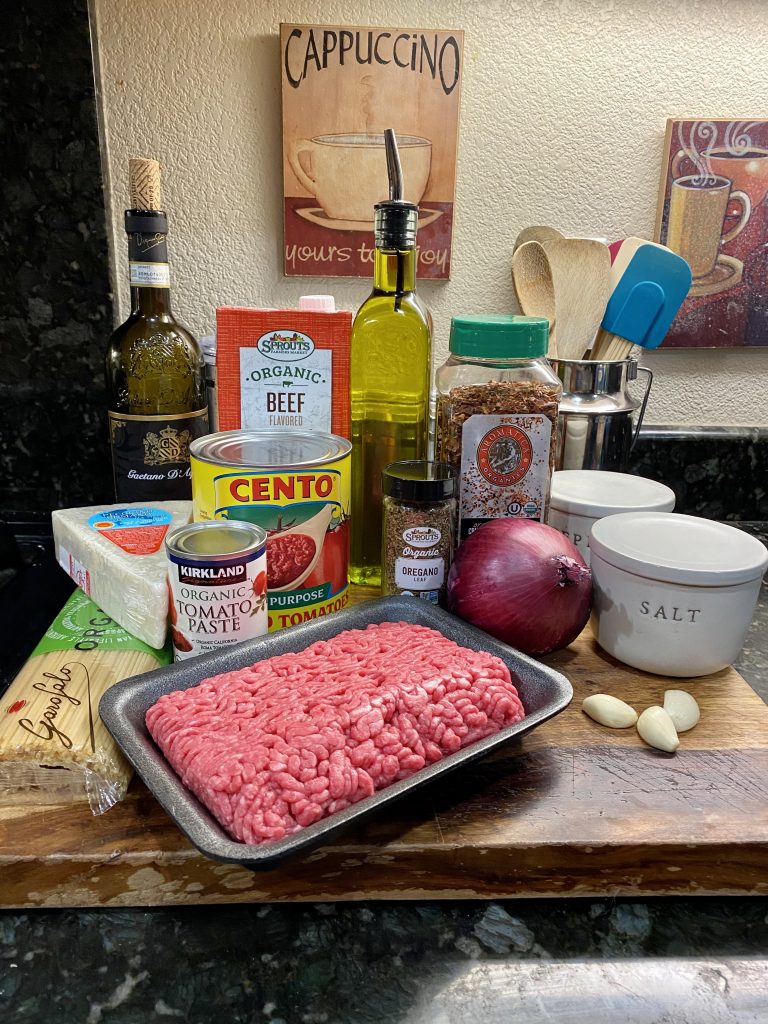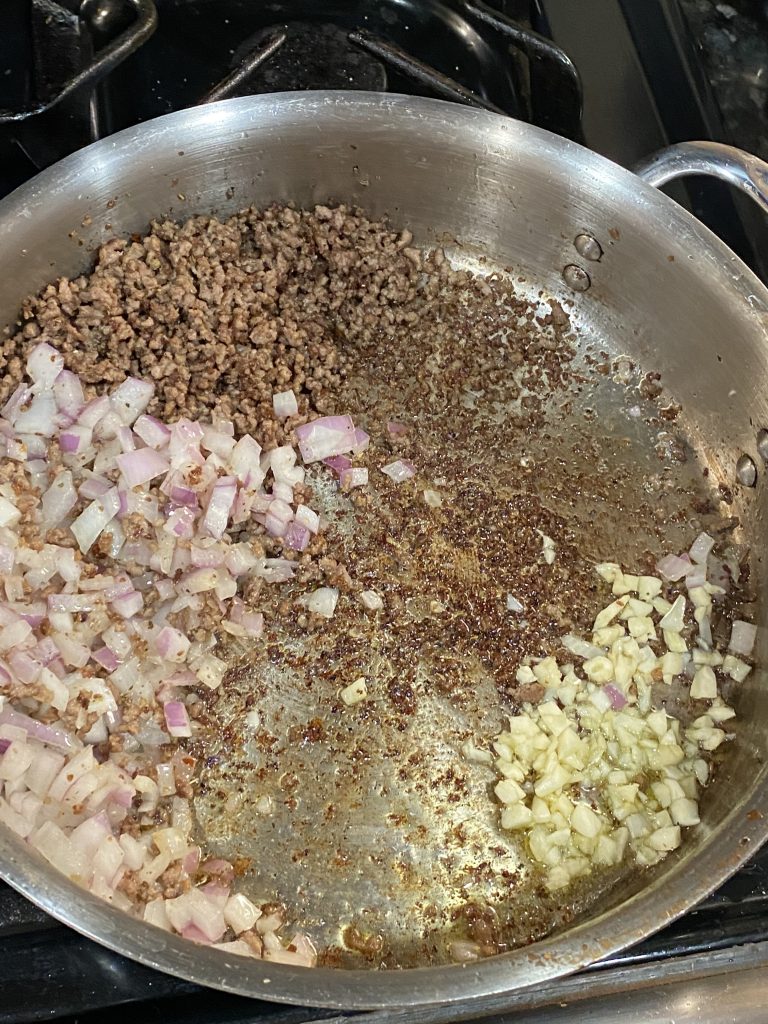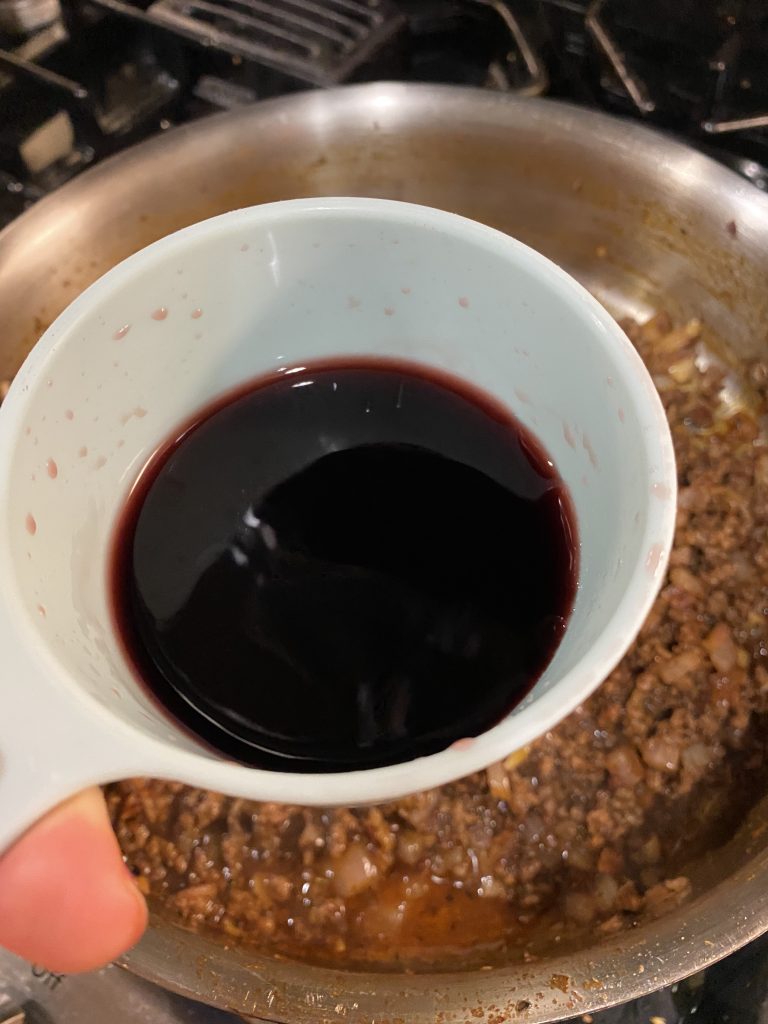Everyday Bolognese

Spaghetti Bolognese is a staple for our family. Being brutally honest, we probably eat it too much. The reason? Well, there are many…
Firstly, it’s easy. Not initially, there’s a bit of a learning curve — but once you’ve practiced it a couple of times, and got it down, it’ll come together so easily you’ll barely feel that you’re cooking! I actually find cooking this recipe therapeutic.
Another reason we eat this so frequently — at least once a week, oftentimes more — is that it lends so well to leftovers. We don’t actually freeze food as well as we should, at least not cooked recipes, but it would be perfect for making a massive batch (doubling the recipe for example), and freezing for a lazy/busy day when cooking dinner is the last thing on your mind. Believe me, it comes out just as good and never fails to satisfy.
This, for our family, is the embodiment of comfort food. A rich, meaty, somewhat creamy sauce, spooned over a plateful of pasta? What’s not to love?
The best part is we don’t even have to ask the kids or anyone before we make this. It’s a beloved dish for the whole family that’s welcome any night of the week!

The list of ingredients is short and relatively straightforward — somewhat surprising when you see the fruits of your labor! How did something so rich, so flavorful, come from so little? At least that was our reaction upon first trying, and savoring the end product of what once seemed to be so challenging.
Indeed, most of these things you should already have in your pantry. If you don’t, start stocking up! Tomato paste, for example is a must, crucial for everything from soups to curries to pastas, and can store indefinitely. Canned tomatoes — we use crushed mostly — is another you should always have on stock. Yes, as every good chef knows, San Marzano (tomatoes sourced from a specific, volcanic region of Italy are always the best), but if you can’t find them, regular ones work just fine as well. Crushed tomatoes work better than Whole Peeled because the consistency of the crushed tomatoes lends itself well to the texture of sauce you’re looking for. Red wine and beef stock are used to deglaze the plan. A red onion, garlic, oregano and red pepper flakes round off the list — along with the basics like olive oil, salt and pepper. Parmesan or pecorino cheese is also a must for the finishing touch (and please, if you can, invest in a microplane for grating, you won’t regret it!).
Let’s get Cooking!

The first step is a basic beginning to any pasta dish. Get the pan hot — not too hot, you don’t want things (especially the garlic) to burn, but a good medium-high. Add olive oil to pan, no more than 1-2 tablespoons to begin with (also depends on the size of the pan you’re using) — but this is important…ensure that you’re able to coat the pan and get an even cook on the meat.
When the oil begins to ripple in the pan, you know the pan is at the right temperature, and you’re ready to add the meat. You should hear that deeply satisfying crackle of meat searing. A crust is forming, and the magic is happening!
When dealing with any kind of meat, whether searing a burger, steak, piece of chicken or even fish, color equals flavor. This indicates that a caramelization has occurred (the technical term for this is the Maillard reaction,) and that slight, darkened crust is essential to building that rich, savory flavor that embodies this dish. You can use a wooden spoon and make quick, repetitive mashing motions until you get all the meat broken up into small pieces and see some pieces start to turn a darker brown. Another quick tip is to use a potato masher to get the chunks into a smaller size.
Don’t freak out if you start to get a lot of browning on the bottom of the stainless steel pan (as pictured above). You don’t have to sear to this degree, but at least some level of browning is essential for the deglazing step that features a few steps ahead.

Once the meat is all browned and you have bits that are more darker brown, even sticking to the bottom, push the meat aside in the pan and after adding a little extra virgin olive oil to the empty side, add in the onions and cook for 1-2 minutes, until translucent. Add garlic — remembering again not to let it burn. Burnt garlic is the enemy of good flavor, although in this dish, you can repair by simply removing the garlic and adding in a new batch. Mix together meat, onion and garlic after a few minutes.

Tomato paste is a another key to building this flavor. An important thing to note here is to ensure that the bright red color of the paste turns to an almost rusty color in the pan. This ensures that it’s melded with the fat in the pan and will incorporate well into the sauce. As with every step, if you feel there is not enough oil in the pan to ensure an even sear on both meat and onions, please add more.

We’re almost there! The base of the sauce is built, and now it’s time to add the liquids! This step is called “deglazing,” and it’s the single most satisfying step in making this delectable recipe! You will come to love adding that deep, burgundy red wine to the pan, hearing that sizzle and scraping the brown bits of off the bottom of the pan with a wooden spoon, watching as it gently lifts and incorporates into the sauce. Ahhh, getting hungry just writing about it!
And no, despite what anyone tells you, you do not require an expensive bottle of wine, vintage from the early 1900’s, to achieve a good bolognese. Any half-decent (or dirt cheap) dry red will do — we are particularly fond of Chianti which works great in this.
What is important to note, however, is that this is not a dump at once and leave dish. You must give it love throughout! This stage is especially important. Once the wine is added, allow it to reduce and cook off. Again, this is absolutely vital to the ultimate level of flavor in the sauce. I actually fill two different measuring cups with the total amount of red wine and beef stock I need to add, respectively. At first, I add half of the total amount of wine, and then when that is reduced, I add a little beef stock, and I go back and forth adding a little of each until all red wine and beef is added and reduced. The more time and love you give to this step the better your sauce will taste!

So how to tell when sufficient reduction has been achieved, I hear you ask? Good question! I go off a visual description, and know that the optimal point of reduction is when the excess liquid has been evaporated, and what’s left is a somewhat thickened mixture of meat and fluid.

The picture above shows what you’re looking for in the reduction of sauce and meat.
Now you’re ready to add the tomatoes! Here, again you can add in batches, perhaps half at a time. Allow to simmer with everything added for a good hour, watching and stirring occasionally. Remember, this is a sauce of love!
Quick note: You can, very realistically, cut the time down for almost every step (sauteing, simmering, etc), and the end result will still likely be quite tasty. However, remember that the longer you cook this sauce, the better it will taste!
It’s not pictured, but we often add parsley and/or basil to complement and finish the sauce. Again, not essential, but certainly can add an extra layer of flavor or two.

A splash or two (actually a 1/4 cup) of milk, just to cut the acidity of the sauce, finishes the dish. Feel free to add more or less according to your taste, or even omit entirely.
You’re now ready to serve.
Buono!
Ingredients
Equipment
Method
- Add oil to pan
- Add oregano and chilli flakes to pan
- Add ground meat before oil burns
- Add salt to meat and cook until nicely browned
- Add tomato paste, cook out the raw colour (should turn from bright red to almost rust colored
- Once tomato paste and meat is incorporated, add liquidsStart with the wine, 1 cup at a time. Allow time to cook off and reduce, 5 minutes for each cup added Repeat process with Beef stock
- Add half of the crushed tomatoes. Stir well and mix with meat. Cook for 15 minutes
- Add rest of the tomatoes and bring to simmer. Allow to simmer on medium heat for 1 hour
- Boil pasta. Take out 1 minute before package instructions to ensure al dente texture!
- Serve pasta onto plates and spoon sauce over pasta. Garnish with parmesan!